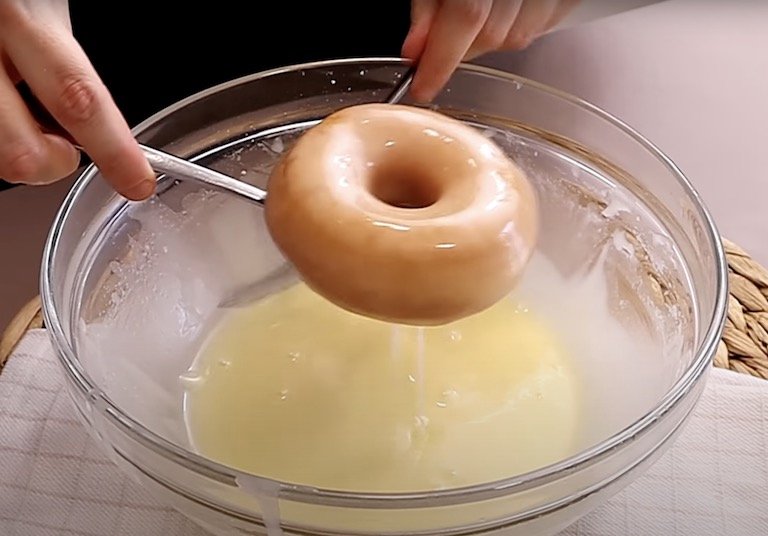Emma Fontanella’s Melt-In-Your-Mouth Glazed Donuts
About my Melt-In-Your-Mouth Glazed Donuts
These classic glazed donuts literally melt in your mouth. They have a light, fluffy, texture and a golden crust. The sugar glaze has the perfect level of sweetness.
Enjoy these as soon as they’re made, while they’re still warm—delicious! I think they’re even better than Krispy Kreme donuts. There, I said it!
This recipe can be found in my new cookbook, Simple Pleasures. In the book you’ll find even more delicious donut recipes, such as authentic Italian donuts, custard-filled donuts, instant donuts, donut holes and more!
What kind of oil should I use for frying the donuts?
At home, the best oils for frying donuts are oils with no flavor or aroma. Vegetable oil, peanut oil, and canola oil are all good choices. After frying donuts, once the oil as cooled, make sure to filter it to remove any solids,and store it in a sealed container for future re-use. You can re-use the same oil for frying four times or more, unless you burnt something or tainted the oil with a strongly flavored ingredient.
Commercially, Krispy Kreme uses vegetable shortening for frying their donuts. That’s a mixture of palm oil, soybean oil, cottonseed oil and canola oil. Additionally, commercial fry oils often have additives designed to make the oil last longer.
What is a yeast-raised donut?
Yeast-raised donuts is what most people think of as regular donuts. They’re made in a similar way to bread, with yeast added to the dough. The live yeast feeds on the flour in the dough, and in the process it creates carbon dioxide which makes the dough rise. So, the rise comes from the yeast, hence the term “yeast-raised”.
Is it better to use yeast or baking powder for donuts?
The answer to this question depends on what kind of donuts you prefer. Yeast donuts are most people’s idea of a classic donut. The use of yeast in these donuts along with the method of working the dough gives the donuts their light, fluffy melt-in-your-mouth texture. If these are the kind of donuts you prefer, then using yeast is the way to go.
Baking powder is used in cake donuts which, as the name suggests, have a slightly denser “cake-like” texture. The use of baking powder means there’s no waiting for the dough to rise when making these kind of donuts. You add the amount of baking powder you need for the recipe. Whereas with yeast donuts, you have to wait for the dough to rise. If cake donuts are what you prefer, then using baking powder is the better option.
EQUIPMENT
A large pan for frying the donuts
INGREDIENTS
For the dough
3 tbsp (40g) unsalted butter
½ cup (120g) whole milk, luke warm
1 egg
½ tsp salt
3 tbsp (45g) white granulated sugar
1 tsp any dried yeast
2 cups (280g) all-purpose flour (high protein content all-purpose flour is best)
¼ tsp ground nutmeg (optional)
For the glaze
5 tbsp (75g) unsalted butter, melted
3 tbsp warm milk
1 tsp vanilla extract
2 cups (250g) powdered sugar
INSTRUCTIONS
Make the dough
In a large bowl, melt the butter.
Wait 5 minutes, just in case the bowl and better are hot. Then add luke warm milk, salt, the egg, sugar and yeast. Using a whisk or a fork, give these ingredients a good mix (about 2 minutes) to allow the sugar to dissolve.
Cover the bowl with a plate and wait 5-10 minutes. After 10 minutes check the bowl. The wet ingredients should have started to form bubbles or be foamy.
Add the flour and optionally the ground nutmeg, and mix to combine. Combine well, until there are no patches of dry flour.
Knead the dough
Knead the dough on a work surface for 10 minutes. If you choose to use a stand mixer knead the dough on high for 3 minutes.
Allow the dough to begin to rise
Cover the bowl with plastic wrap and set aside on your kitchen counter for 2 hours.
Cut out the donuts
Roll out the dough onto a floured work surface.
Cut out the donuts. I use a donut cutter for this, but you can use a cookie cutter if you don’t have a donut cutter. If you like making donuts, though, I recommend investing in a special donut cutter—they’re inexpensive and readily available to buy on-line.
Cutting out a donut
Place the cut out donuts on pieces of parchment paper ( the parchment paper helps you lower the donuts in the oil without messing with the donut shape).
Final proofing of the donuts
Cover the cutout donuts with plastic wrap, and allow the donuts to rise one last time at room temperature for around 45 minutes to 1 hour, until doubled in size. The exact timing will depend on how warm your kitchen is.
The donuts ready for their final rise
Fry the donuts
Preheat your frying oil in the pan to 360°F (180°C to190°C). Then, add the donuts to the hot oil using the parchment paper to avoid touching the delicate donuts.
Adding the donuts to the hot oil using the parchment paper to avoid touching the delicate donuts.
Fry in batches at for about 2 minutes on each side or until they are golden (not brown).
Remove from the oil and place them on a rack.
Glaze the donuts
In a large bowl, make the glaze by mixing together melted butter, warm milk, sugar and vanilla extract.
Toss the donuts in the glaze and enjoy!
Glazing a donut
Watch the video for more tips on making these donuts
Hi! I’m Emma Fontanella. Here you’ll find trusted, tested recipes to satisfy your baking addiction and carb cravings. Learn more…
Tried one of my recipes? Please let me know on Instagram (@emmafontanella) or TikTok (@emma.fontanella)! Hashtag #emmafontanella
Search for another recipe…






